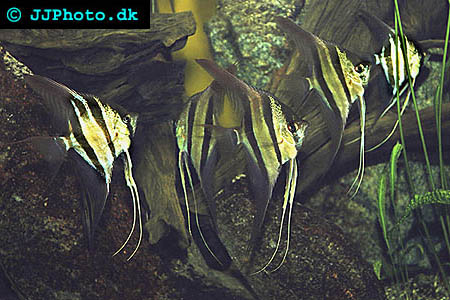Altum Angelfish
Scientific name: Pterophyllum altum
The Altum Angelfish is a close relative to the common freshwater angelfish and can be found in a relatively large area around Rio Orinoco and Rio Negro in Brazil, Venezuela and Colombia. It has long been thought and it is still a popular myth, even among experts that the Altum Angel fish (Pterophyllum altum ) only can be found in Rio Orinoco however this is proven incorrect by studies of specimens in different museums that has been collected in a much larger area.The Altum Angelfish are not so widely available in the aquarium trade due to being more sensitive and harder to breed then the common freshwater angelfish (Pterophyllum scalare) You should however be able to Altum angel fish without to much problem, but you will however have to be prepared to the fact these fish can be quite expensive, especially compared to the regular angel. Anything between 20$ and 50$ are to be considered a normal price depending on size of the Altum Angelfish. Make sure that the fish you buy actually are Altum angelfish since fish sometimes are sold wrongfully as altum angelfish when they in reality are regular angelfish or Peruvian altum angelfish which might be a separate yet undescribed species or a sub species to the regular angelfish.
The word Altum in their name Altum angel fish is a Latin word that means tall and is a suitable name for this species since they can develope a very high body that can reach 30cm/12" in height while they only reach a length of 15cm/6"
Altum angelfish is as earlier mentioned considerable more sensitive then the regular angelfish and needs a care similar to that of discus fish. They need due to their height a high aquarium tank and should never be kept in aquariums shallower then 75cm/ 30". The aquariums don’t need to be very large in other aspects and an aquarium that is 120 cm/ 4 ft long is sufficient. The aquarium should be decorated with large pieces of bogwood that if possible should reach the waters surface. Large leafed plants like Amazon swordsplants can also be beneficial and are usually left alone. The water should be kept in very soft water that is not so slightly acidic. A pH level of 4.5-6.5 is suitable for Altum Angelfish. They prefer very warm water and they are best kept in 28-30°C / 82-86°F. The nitrates levels should be kept very low and the water should be slightly circulated to mimic the environments this species are normally found in, in the wild
Altum angelfish are suitable to be kept with most calm fish, and are ideally kept with other calm species from the same area such as Discus and Tetras. Small fish might be considered food and should not be kept with cardinal and neon tetras since Altum angelfish as all angelfish seems very fond of eating these. They should never be kept with regular angelfish since they can hybridise with (Pterophyllum scalare)

Altum Angelfish – Pterophyllum altum. Copyright www.jjphoto.dk
It is very hard to sex these fish outside the breeding period and the methods that exist are anything but reliable. Altum Angelfish can be breed in aquarium but this is not an easy task. The species can be breed in a similar fashion to the regular angelfish and discus fish. The first obstacle is to get a suitable breeding pair of Altum Angelfish and the best way to get this is to buy a larger group of 8-10 fish which are allowed to form Pairs themselves. The species will then need to be properly conditioned with a varied diet consisting of live and frozen food before getting into spawning condition. Altum angelfish are much pickier when it comes to water condition then the regular angelfish and will only breed in soft acidic water. The parents guard the fry and are usually better parents than regular angelfish. The fry can be feed newly hatch brine shrimp.
The Altum angelfish is a more delicate flower than the regular angelfish and requires a more caring environment but is without a doubt worth the extra effort.
Didn't find the info you were looking for? Register for free and ask your question in our Aquarium forum !
Our knowledgeable staff usually responds to any question within 24 hours
Related Articles
Altum Angelfish - Information about Altum Angelfish
Angelfish / Scalare history - Information about Angelfish / Scalare history
Chocolate Cichlids - Information on keeping and breeding chocolate cichlids.
Breeding Parachromis - Information about Breeding Parachromis
Breeeding Oscar Fish - Breeding oscars
Cichla - A short introduction to Cichla cichlids
Crenicichla - Information about Crenicichla
Crenicichla Breeding - Information about Crenicichla Breeding
Crenicichla sp. "Pacaya" - A guide to keeping this seldom seen fish.
Crenicichla Types - Information about Crenicichla Types
Feeding Pike Cichlids - A guide on how to best feed your Pike cichlids - Crenicichla -
Green terror Cichlids - Information about all aspects of green terror cichlids, their care and breeding.
Introduction to Pike Cichlids - An introduction to pike cichlids and their care.
Keeping Parachromis in aquariums - Information about Keeping Parachromis in aquariums
Keyhole Cichlid - Information about how to keep, care for and breed keyhole cichlids.
Neo-Tropical Dwarf Cichlid Husbandry - A general introduction to keeping and breeding dwarf cichlids.
Oscar cichlids - A short introduction to oscar cichlids
Spangled Pike Cichlids of the Saxatilis Group - none
Dicrossus maculatus - spade tail checkerboard cichlid - The spade-tail checkerboard cichlid is seldom seen and is difficult to breed.
The Spotted Demonfish, Satanoperca daemon - A guide on how to breed the spotted demonfish
